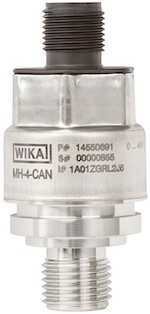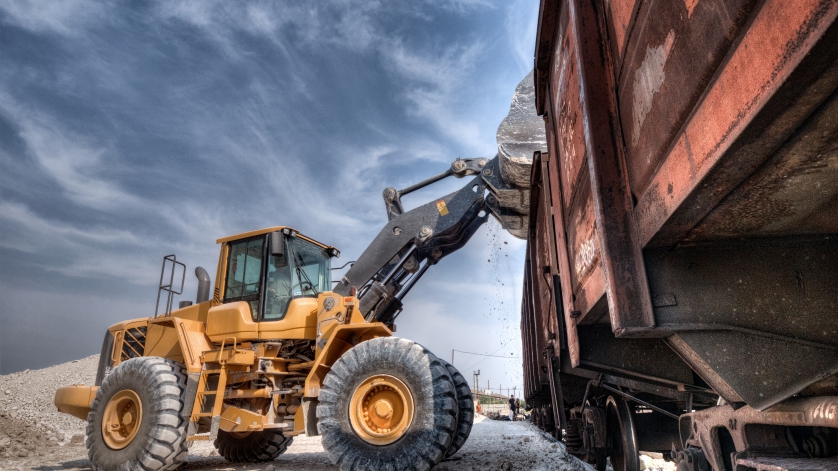
The digitalization of mobile hydraulics systems means that industrial vehicles require a greater number of advanced sensors. WIKA’s MH-4-CAN is a high-quality yet cost-effective OEM pressure transmitter with CANopen or SAE J1939 output signals.
Digital control of hydraulic systems allows better management and improved performance of mobile machines. When properly controlled, equipment such as steering systems, drive regulators, and transmission gear are safer, work more efficiently, and – ultimately – save users time and money. WIKA offers top-of-the-line instrumentation that can help OEMs incorporate digital control to the increasingly complex and demanding applications of today’s off-road machinery.
The Advantages of a Controller Area Network (CAN)
To achieve effective control in mobile machine applications, information about the status of each device must be relayed to other parts of the system. A Controller Area Network (CAN) bus does that quickly and efficiently. A pressure sensor – or any other type of sensor, such as for rotation or inclination – transmits its output signal via the CAN bus for any electronic control unit (ECU) to use when controlling machine functions like load moment control. Each sensor’s output signal has a defined node so that an ECU knows where the message is coming from. Several ECUs can use the same CAN bus and the same signal.
CAN has become the standard for communications among devices in mobile machines and allows very good control and optimization of processes. Such systems are economical, easy to wire, and have good transfer rates, even without repeaters. However, the output signal of standard pressure transmitters in most mobile machine applications is analog and cannot be communicated through CAN, which operates only with digital signals that follow a defined protocol. Electronic pressure measuring instruments with digital output signals compatible with communications protocols were not common, and those that were available were expensive and difficult to integrate.

MH-4-CAN
MH-4-CAN: Next-Gen Pressure Transmitter for Mobile Machinery
To address this particular problem of the mobile machine market, WIKA’s experts came up with the MHC-1 electronic pressure transmitter, which converts an analog pressure signal to binary, and formats it according to the requirements of the chosen communications protocol, either CANopen or SAE J1939.
OEMs appreciated the MHC-1’s durability, accuracy, and customizability, and installed this sensor in a wide variety of mobile machines. Among their kudos was a short list of features they’d like to see in a future model. WIKA engineers took their suggestions back to the lab, and came up with the MH-4-CAN.
This state-of-the art OEM pressure transmitter has several advantages over its predecessor:
- Smaller footprint. The MH-4-CAN is notably smaller, with a housing height of 1.2” (5mm) compared to the MHC-1’s 2.44” (62mm).
- Better performance. This maintenance-free transmitter can withstand up to 40 g of vibration, 100 g of shock, and 3 times its overpressure limit for even greater resistance against hydraulic pressure spikes.
- More process connections. The MH-4-CAN can be manufactured with one of 18 types of international pressure connection threads, as opposed to just four with the MHC-1.
- Lower price points. This OEM pressure transmitter is very competitively priced among CAN transmitters in the marketplace, with lower per-unit cost for larger orders.
The MH-4-CAN is specifically designed to withstand the extreme and harsh working conditions that mobile machines face. Its pressure range is 0…8,000 psi (0…600 bar) and measures with high precision at temperatures between −40°F and 212°F (−40°C and 100°C). All stainless steel construction shields the sensor from electromagnetic interference at field strengths of up to 60 V/m. The output signal is formatted to follow either the CANopen or SAE J1939 protocols, and the sensor can be delivered pre-configured so that it is ready to be incorporated into the system.
During the R&D phase, more than 1,400 pieces went through 11 mechanical tests, 30 electrical tests, and 23 environmental assessments to verify quality over the transmitter‘s entire service life of 100 million load cycles. WIKA also submitted the MH-4-CAN to 15 customer-specific tests to validate its performance for use in cranes and construction/agricultural machinery.
A highly flexible, fully automated production line makes it easy to fulfill high-volume orders. And because the process steps are flexible, WIKA can easily accommodate customer-specific modifications, including:
- Special measuring ranges (free of charge)
- Addition of .3mm restrictor for the process connection (additional charge)
- intelligent serial numbers (free of charge)
- Brand-specific labeling (additional charge)
The MH Family of Sensors for Mobile Hydraulics
Model MH-4-CAN joins other high-quality pressure sensors for OEMs:
- MH-4 –pressure sensor with current, voltage, ratiometric, or pulsewidth modulation (PWM) signal types
- MH-3-HY – pressure sensor for mobile hydrogen applications
On the horizon is a MH-4 variant with dual outputs of both pressure and temperature.
WIKA USA, Your Partner in Smart Sensing
Industrial vehicles experience significant vibration/shock and have to perform reliably in conditions ranging from desert to tundra. They are also becoming more automated. The pressure transmitters used in these hydraulics and control systems must be equally resilient, reliable, and smart. Contact WIKA USA to find out more about the MH-4-CAN and other smart sensing solutions for manufacturers of mobile working machines.
Products mentioned in this article:
• CTL-S700 series compact safety controllers
• Load moment indication, qSCALE rated capacity limiter (RCL) trueSafety
• MH-4-CAN OEM pressure sensor for mobile machines
• MH-4 OEM pressure sensor for mobile machines
• MH-3-HY OEM pressure sensor for mobile hydrogen applications
Learn more about WIKA products in Mobile Machines here.


